|
|
Update: To our knowledge, this charcoal is no longer available. If you have any information,
feel free to contact us using this link: Email The Whiz
|
It has been just shy of five years since we last reviewed this charcoal, (you can read our 2002 review of this charcoal here) and we have burned a lot of charcoal since then. We have added new tests to our reviews since then, including burntime and ash production, and we have been weighing the charcoal as a part of our reviews. Also we have obviously accumulated a large body of results from different brands of charcoal for comparison. So, will this charcoal keep its top rating?
Before we look at this charcoal, we want to be sure everyone knows how we got this charcoal. A reader who ordered a large quantity of this charcoal from Kamado offered to ship us two boxes for this review. Both the reader and the Lump Charcoal Database affirm that these two boxes were purchased from Kamado, and that the state of the charcoal in this review is as it was when it was received from Kamado.
Ok, chit chat out of the way, let's do the review. First of all, tamarind is not your ordinary charcoal wood here in the United States, so here is some information about tamarind:
"Evergreen tree (Tamarindus indica) of the pea family (see legume), native to tropical Africa and cultivated elsewhere as an ornamental and for its edible fruit. The tree grows about 80 ft (24 m) tall and has featherlike leaves. It bears small clusters of yellow flowers and plump pods that do not split open. The soft, brownish edible pulp contains 1-12 large, flat seeds that are used in Oriental foods, beverages, and medicines.
The sapwood of the tamarind tree is pale-yellow. The heartwood is rather small, dark purplish-brown, very hard, heavy, strong, durable and insect-resistant. It bends well and takes a good polish and, while hard to work, it is highly prized for furniture, panelling, wheels, axles, gears for mills, ploughs, planking for sides of boats, wells, mallets, knife and tool handles, rice pounders, mortars and pestles. It has at times been sold as "Madeira mahogany". Wide boards are rare, despite the trunk dimensions of old trees, since they tend to become hollow-centered. The wood is valued for fuel, especially for brick kilns, for it gives off an intense heat, and it also yields a charcoal for the manufacture of gun-powder. In Malaysia, even though the trees are seldom felled, they are frequently topped to obtain firewood. The wood ashes are employed in tanning and in de-hairing goatskins. Young stems and also slender roots of the tamarind tree are fashioned into walking-sticks."
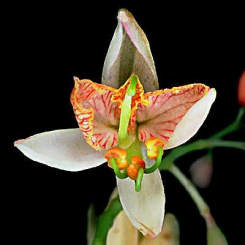
Figure 1. Tamarind flower |
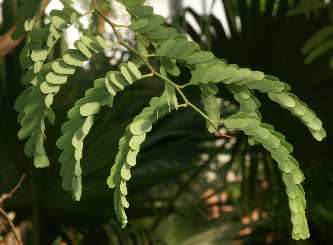
Figure 2. Tamarind foliage |
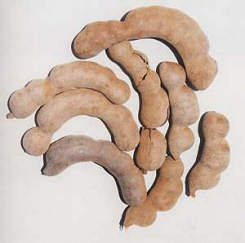
Figure 3. Tamarind fruite |
When we opened a box, it appeared that there is a nice distribution of sizes. This table shows what we found:
| Large |
2.4 pounds |
23.5% |
| Medium |
2.3 pounds |
23.1% |
| Small |
5.3 pounds |
51.4% |
| Chips/Dust |
0.2 pounds |
1.9% |
|
|
|
| Total |
10.2 pounds |
|
|
Er, there's something wrong there. Did you spot it? Here's a clue from the box:

It appears that the box is over 2 pounds underweight! We were shocked since we have never had any brand of charcoal be underweight since we started including weighing as a part of our review regimen. So, we opened up the second box, sorted it and weighed it. Here's what we found on the second box:
| Large |
3.1 pounds |
35.5% |
| Medium |
2.4 pounds |
27.4% |
| Small |
2.4 pounds |
27.5% |
| Chips/Dust |
0.8 pounds |
9.6% |
|
|
|
| Total |
8.7 pounds |
|
|
This box is nearly 4 pounds underweight! We are going in the wrong direction! We contacted one of Kamado's customers who made a large purchase of the Tamarind lump charcoal and asked him to weigh some of his boxes. He selected five boxes at random and reported the following weights:
8 pounds 11 ounces
8 pounds 11 ounces
9 pounds 1 ounce
9 pounds 11 ounces
11 pounds 6 ounces
Note that the weights reported by our contact include the weight of the plastic bag, so the charcoal itself actually weighed slightly less. That makes 7 boxes out of 7 that are seriously underweight, some of them by as much as 30%.
The next thing we noticed when we opened the boxes was a bit of a damp, musty smell. In digging through the charcoal, we discovered that much of it was partially covered with mold. Apparently Kamado continues to struggle with delivering charcoal to the United States in good shape. (At least one shipment of the coconut charcoal briquettes from Thailand which they sold in 2006 had mold problems.) Here are photos of what we observed:
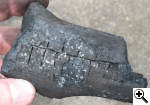
Mold on Kamado Tamarind Charcoal.
|
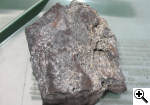
Mold on Kamado Tamarind Charcoal.
|
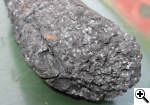
Mold on Kamado Tamarind Charcoal.
|
Again we contacted the Kamado customer who had ordered a large amount of this charcoal to see if they also had mold on their charcoal. They reported that "Several of the boxes had condensation in them upon initially opening them and several appear to have a white mold growing on them." They sent us these photos:
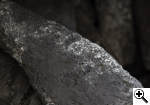
Mold on Kamado Tamarind Charcoal.
|
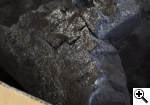
Mold on Kamado Tamarind Charcoal.
|
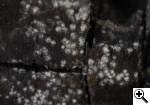
Closeup of mold on Kamado Tamarind Charcoal.
|
We asked them to check the boxes to see how many had mold and they reported, "All of them had some sort of mold. Four had moderate to severe growth and one had scant growth." So it seems that the mold appears to be a problem in all the boxes we have checked.
As for burning characteristics, this charcoal is very easy to start, requiring only 2 sheets of newspaper in our chimney starter test. There was no sparking or popping worth mentioning during starting. When we started a load of the charcoal with a MAPP torch, there also were no sparks or popping worth mentioning. Of course, we will repeat our now-obligatory recommendation that you always exercise care when starting charcoal with a MAPP torch.
The smoke from this charcoal is very very nice. Mild and perfumey, for whatever reason, we think it begs to cook beef. So we did, cooking a large prime rib bone-in steak, and the steak turned out great.
In our burn test, it burns an average length of time compared to other charcoals we have tested. The ash produced is problematic, however. This charcoal produced the highest amount of ash we have ever measured from a true lump charcoal. (We are excluding the results from the Kamado coconut charcoal briquettes in this comparison as it is not really lump charcoal.) Ash management might be necessary for a long overnight cook in some cookers.
This charcoal might have received an Above Average rating if it weren't for the problems we found with mold and the weight. However, we have never had a charcoal that was covered with mold before, and we have never tested charcoal that contained 30% less charcoal than the packaging indicated. We cannot possibly recommend a charcoal with these problems and thus we have to give it our Not Recommended rating.

|





